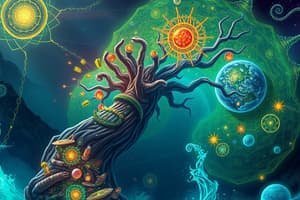Podcast
Questions and Answers
Which domain includes single-celled prokaryotic microorganisms?
Which domain includes single-celled prokaryotic microorganisms?
- Fungi
- Archaea
- Eukarya
- Bacteria (correct)
What is a key characteristic of bacteria in terms of energy production?
What is a key characteristic of bacteria in terms of energy production?
- Photoautotrophic
- Heterotrophic (correct)
- Saprotrophic
- Parasitic
What distinguishes Archaea's cell wall chemistry from that of Bacteria?
What distinguishes Archaea's cell wall chemistry from that of Bacteria?
- Presence of a nucleus
- Binary fission reproduction
- Requirement of sunlight for survival
- Different cell wall chemistry (correct)
Which domain is known to inhabit extreme environments such as hot springs and salt lakes?
Which domain is known to inhabit extreme environments such as hot springs and salt lakes?
What is a common mode of reproduction for bacteria?
What is a common mode of reproduction for bacteria?
Which domain includes organisms that can live symbiotically with humans, particularly in the digestive system?
Which domain includes organisms that can live symbiotically with humans, particularly in the digestive system?
What distinguishes archaeal cells from eukaryotic cells?
What distinguishes archaeal cells from eukaryotic cells?
How do archaeans move, distinguishing them from most bacteria?
How do archaeans move, distinguishing them from most bacteria?
What process do eukaryotes undergo during sexual reproduction?
What process do eukaryotes undergo during sexual reproduction?
Which organisms belong to the Eukarya kingdom?
Which organisms belong to the Eukarya kingdom?
How do bacteria reproduce, in contrast to archaeans?
How do bacteria reproduce, in contrast to archaeans?
What distinguishes eukaryotic cells from bacteria?
What distinguishes eukaryotic cells from bacteria?
Flashcards are hidden until you start studying
Study Notes
In biology, understanding the three domains of life is crucial because they form the basis of all living organisms. These domains—Bacteria, Archaea, and Eukarya—are distinct from one another due to their cellular structures, evolutionary history, and genetic makeup. Here's a brief overview of each domain and its units of classification:
Bacteria
The first domain is Bacteria, which includes single-celled prokaryotic microorganisms. They lack a nucleus, have a simple structure with a plasma membrane surrounding basic cytoplasmic constituents, and replicate through binary fission. There are thousands of species within this domain, including those that live symbiotically with humans like those found in our digestive system.
Some key characteristics of bacteria include being heterotrophic, meaning they require organic compounds for energy production; they can reproduce quickly; some produce light by photosynthesis (photoautotrophic); others break down waste materials (saprotrophic). Classification into more specific groups depends upon their mode of nutrition, type of endospore formation, movement, Gram staining reaction, etc..
Archaea
Archaea, also known as archaebacteria, has a slightly different cell wall chemistry compared to bacteria. Organisms in this group often inhabit extreme environments such as hot springs, salt lakes, or sulfur deposits. However, they share many other similarities too - both types need nutrients, water, sunlight, and air to survive. While archaeal cells contain DNA and RNA, they do not possess mitochondria. This distinguishes them from eukaryotes since these organelles house part of the metabolic activity of a cell.
Microscopic examination might reveal differences between bacterial and archaeal cells. For instance, while most bacteria have flagella and pili used for motility, some archaeans move via gliding motion using their unique cell walls. Despite having common features with bacteria, it was once believed they were related to plants rather than animals! Now we know better thanks to modern science.
Eukarya
Eukarya, also called eukaryotes, are multicellular organisms consisting of complex cells containing various specialized subunits. Cells belonging to this kingdom typically feature larger structures inside their cells when compared to bacteria — they contain internal membranes that separate parts of the cell (like Golgi apparatuses), unlike bacteria where everything mixes freely together. Some well-known examples of eukaryote organisms include yeast, fungus, algae, protozoan, slime molds, insects, fish, birds, mammals, etc..
In terms of reproduction and growth processes, eukaryotes experience meiosis during sexual reproduction followed by fertilization just like us human beings do. On the other hand, bacteria undergo binary fission whereas archaeans sometimes undertake budding instead. Aside from being multicellular, eukaryotes tend to grow much slower than bacteria who divide rapidly. But remember: even though we call something small doesn't mean it isn't important.
These domains represent major divisions among all forms of life. Each one provides information essential for understanding how life works today and helps scientists piece together theories regarding natural selection and the origin of life itself. So next time you sip your morning coffee make sure to appreciate that very special ingredient – yes, your cup of tea contains bacteria too!
Studying That Suits You
Use AI to generate personalized quizzes and flashcards to suit your learning preferences.




